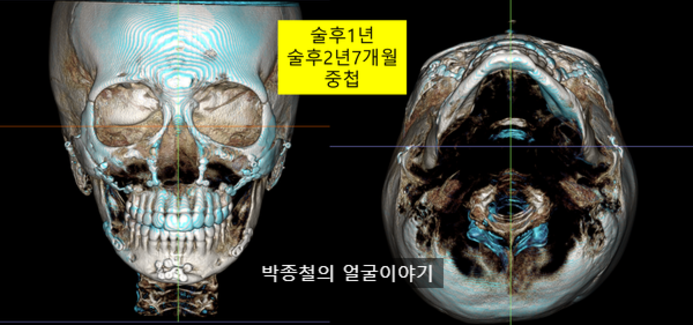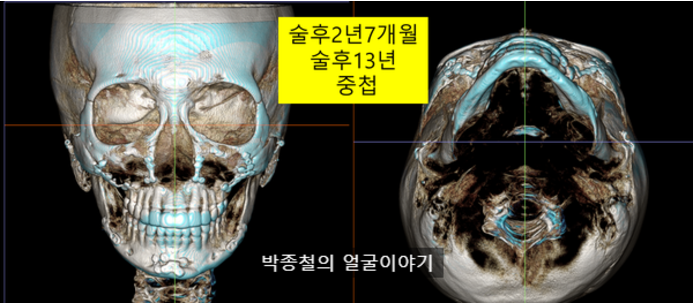Long-term Effects of Asymmetric Orthognathic Surgery: A 13-Year Follow-up Case Study
- Dr. Park

- Dec 2, 2024
- 3 min read
Orthognathic surgery, particularly asymmetric orthognathic surgery, is a significant procedure that impacts not only aesthetics but also crucial functions such as mastication, pronunciation, and swallowing. 1 This procedure requires careful consideration of surgical planning, postoperative management, and prediction of long-term changes. This case study presents a 13-year follow-up analysis of a patient who underwent asymmetric orthognathic surgery, focusing on the possibility of relapse, condylar position changes, and their implications.
CR-CO Discrepancy
What is CR-CO Discrepancy?
CR-CO discrepancy refers to the difference between a patient's centric relation (CR) and centric occlusion (CO). In asymmetric patients, there is a tendency to consciously adjust jaw position, which can lead to a discrepancy between the condylar position in CO and the actual maximum intercuspation

CR-CO Discrepancy In this case, a CR-CO discrepancy was observed in the right condyle, potentially related to the patient's rightward chin deviation.
Implication: Surgical planning without considering CR-CO discrepancy can result in undercorrection of asymmetry. Accurate diagnosis and meticulous surgical planning are crucial.
Surgical Planning and 1-Year Postoperative Changes
Surgical Plan: To correct the 5.43mm rightward deviation of the chin, bimaxillary surgery including maxillary movement was performed.

Asymmetric Orthognathic Surgery 1-Year Postoperative Condylar Position Changes: Upward movement of the upper lip, anteroinferior movement of the right condyle, and downward movement of the left condyle were observed. Between 5 weeks and 1 year postoperatively, minimal changes were observed in the right condyle, while the left condyle showed continuous downward displacement.

비대칭 양악수술 1년 과두변화 Implication: Monitoring skeletal changes over a long period, exceeding 1 year postoperatively, is essential.
Long-term Postoperative Changes (1 Year, 2 Years 7 Months, 13 Years)
1 Year vs. 2 Years 7 Months: Skeletal changes were minimal, but improvement in the double chin was observed, suggesting the influence of tongue position and posture on surgical outcomes.

비대칭양악수술 후 장기적인 변화 (1년, 2년 7개월, 13년) 
비대칭양악수술 후 장기적인 변화 (1년, 2년 7개월, 13년) 2 Years 7 Months vs. 13 Years: Minimal changes were observed in the maxilla, while the mandible showed slight leftward movement. The left condyle displayed posteroinferior displacement, potentially due to mandibular displacement or condylar remodeling. Increased upper and lower lip contact was noted, with minimal change in lower lip height.

비대칭양악수술 후 장기적인 변화 (1년, 2년 7개월, 13년) 
비대칭양악수술 후 장기적인 변화 (1년, 2년 7개월, 13년) Implication: Subtle skeletal changes can occur even after asymmetric orthognathic surgery over the long term, necessitating continuous follow-up and management.
Condylar Position Changes
13 Years Postoperatively: The right condyle was positioned anteriorly compared to its preoperative position, while the left condyle showed posteroinferior displacement. Thickening of the superior bone of the left glenoid fossa was observed.

Long-term Effects of Asymmetric Orthognathic Surgery: condyle position 
Long-term Effects of Asymmetric Orthognathic Surgery: condyle position Implication: Condylar position changes can affect temporomandibular joint health and function, requiring careful observation over the long term.
Soft Tissue Changes
13 Years Postoperatively: The upper lip showed slight upward movement, although it remains unclear whether this is attributable to orthognathic surgery or rhinoplasty. The lower lip showed a clear upward movement. Compared to 1 year postoperatively, the upper lip descended slightly, resulting in increased upper and lower lip contact.

Long-term Effects of Asymmetric Orthognathic Surgery: A 13-Year Follow-up Case Study Implication: Orthognathic surgery influences soft tissues, playing a crucial role in aesthetic outcomes.
Asymmetry Relapse
13 Years Postoperatively: No noticeable asymmetry relapse was observed.

Long-term Effects of Asymmetric Orthognathic Surgery: A 13-Year Follow-up Case Study Implication: Although this case showed no relapse after 13 years, this may not apply to all patients.
Conclusion
This 13-year follow-up analysis demonstrates that skeletal and soft tissue changes can occur over the long term even after asymmetric orthognathic surgery. Factors such as condylar position changes and CR-CO discrepancy need to be considered. Accurate diagnosis, meticulous surgical planning, and continuous follow-up observations are essential for successful surgical outcomes.



Comments